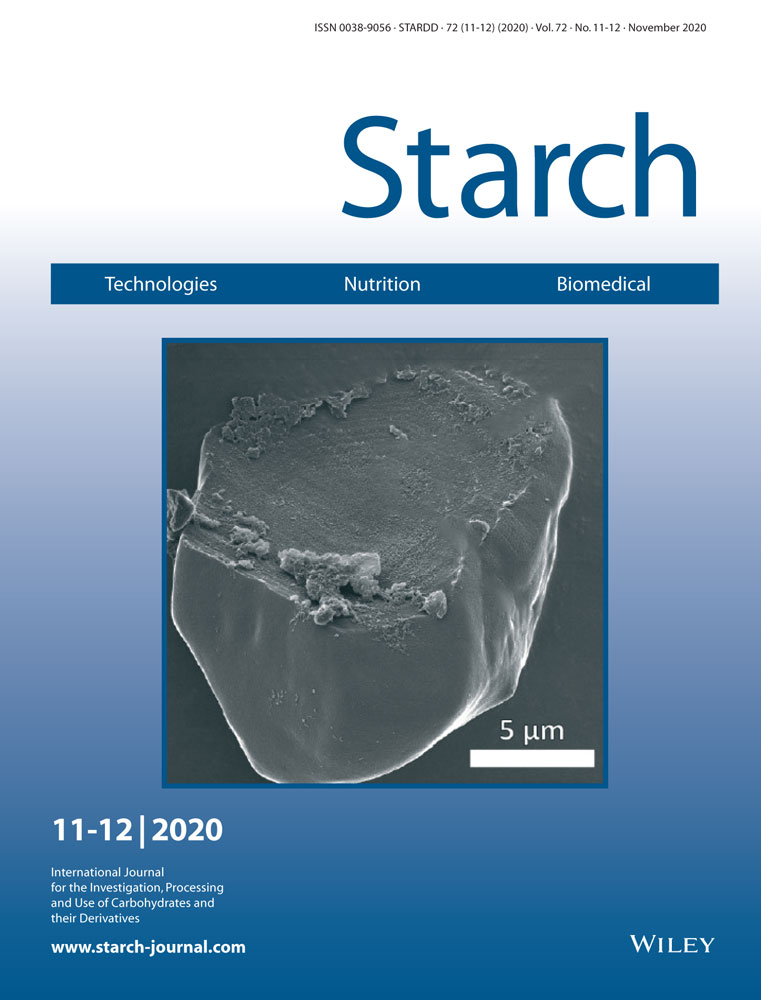Structural Properties Change of Cassava Starch Granule Induced by High Shear Mixer
Bramantyo Airlangga
Chemical Engineering Department, Faculty of Industrial Technology, Institut Teknologi Sepuluh Nopember (ITS), Kampus ITS Sukolilo, Surabaya, 60111 Indonesia
Search for more papers by this authorFebriyati Puspasari
Chemical Engineering Department, Faculty of Industrial Technology, Institut Teknologi Sepuluh Nopember (ITS), Kampus ITS Sukolilo, Surabaya, 60111 Indonesia
Search for more papers by this authorPrida Novarita Trisanti
Chemical Engineering Department, Faculty of Industrial Technology, Institut Teknologi Sepuluh Nopember (ITS), Kampus ITS Sukolilo, Surabaya, 60111 Indonesia
Search for more papers by this authorJuwari
Chemical Engineering Department, Faculty of Industrial Technology, Institut Teknologi Sepuluh Nopember (ITS), Kampus ITS Sukolilo, Surabaya, 60111 Indonesia
Search for more papers by this authorCorresponding Author
Sumarno
Chemical Engineering Department, Faculty of Industrial Technology, Institut Teknologi Sepuluh Nopember (ITS), Kampus ITS Sukolilo, Surabaya, 60111 Indonesia
Email: [email protected]
Search for more papers by this authorBramantyo Airlangga
Chemical Engineering Department, Faculty of Industrial Technology, Institut Teknologi Sepuluh Nopember (ITS), Kampus ITS Sukolilo, Surabaya, 60111 Indonesia
Search for more papers by this authorFebriyati Puspasari
Chemical Engineering Department, Faculty of Industrial Technology, Institut Teknologi Sepuluh Nopember (ITS), Kampus ITS Sukolilo, Surabaya, 60111 Indonesia
Search for more papers by this authorPrida Novarita Trisanti
Chemical Engineering Department, Faculty of Industrial Technology, Institut Teknologi Sepuluh Nopember (ITS), Kampus ITS Sukolilo, Surabaya, 60111 Indonesia
Search for more papers by this authorJuwari
Chemical Engineering Department, Faculty of Industrial Technology, Institut Teknologi Sepuluh Nopember (ITS), Kampus ITS Sukolilo, Surabaya, 60111 Indonesia
Search for more papers by this authorCorresponding Author
Sumarno
Chemical Engineering Department, Faculty of Industrial Technology, Institut Teknologi Sepuluh Nopember (ITS), Kampus ITS Sukolilo, Surabaya, 60111 Indonesia
Email: [email protected]
Search for more papers by this authorAbstract
In this work, a high shear mixer (HSM) is designed to produce a higher theoretical shear rate than conventional HSM in order to induce structure degradation of cassava starch granules. Using scanning electron microscopy and transmission electron microscopy, the processed cassava starch granule surface changes are identified without any major change in the granule shape. The carbohydrate component analysis and intrinsic viscosity suggest that the structural change is led by the removal of a relatively low-molecular-weight carbohydrate component from the granule. The changes in the crystalline and thermal properties are observed by the degradation process using a HSM. The process using a rotor speed of 15 000 rpm is found to significantly induce granule surface changes and carbohydrate removal. The decrease in granule crystallinity is correlated with an increase in the granule swelling power and solubility.
Conflict of Interest
The authors declare no conflict of interest.
References
- 1J. BeMiller, R. Whistler, Starch Chemistry and Technology, 3rd ed., Academic Press, Massachusetts, USA 2009.
- 2A. Bertolini, Starches: Characterization, Properties, and Applications, CRC Press, Boca Raton, FL 2010.
- 3R. Hoover, Food Reviews International 2000, 16, 369.
- 4S. Pérez, E. Bertoft, Starch 2010, 62, 389.
- 5E. Bertoft, Agronomy 2017, 7, 56.
- 6R. D. Hancock, B. J. Tarbet, J. Chem. Educ. 2000, 77, 988.
- 7M. Sujka, J. Jamroz, Food Hydrocolloids 2013, 31, 413.
- 8E. Hermiati, J. I. Azuma, S. Tsubaki, D. Mangunwidjaja, T. C. Sunarti, O. Suparno, B. Prasetya, Carbohydr. Polym. 2012, 87, 939.
- 9S. Lagarrigue, G. Alvarez, J. Food Eng. 2001, 50, 189.
- 10J. Wang, L. Yu, F. Xie, L. Chen, X. Li, H. Liu, Starch 2010, 62, 667.
- 11S. Kaur, A. Kaur, N. Singh, N. S. Sodhi, Starch 2013, 65, 808.
- 12M. Shahbazi, M. Majzoobi, A. Farahnaky, J. Food Eng. 2018, 223, 10.
- 13J. Tamminen, T. Koiranen, Can. J. Chem. Eng. 2015, 93, 2245.
- 14K. Kuhn, S. Schlauch, Starch 1994, 46, 208.
- 15A. Utomo, M. Baker, A. W. Pacek, Chem. Eng. Res. Des. 2009, 87, 533.
- 16F. Puspasari, B. Airlangga, P. N. Trisanti, Sumarno, IOP Conf. Ser.: Mater. Sci. Eng. 2019, 673, 012135.
- 17M. Sujka, Ultrason. Sonochem. 2017, 37, 424.
- 18Y. Monroy, S. Rivero, M. A. García, Ultrason. Sonochem. 2018, 42, 795.
- 19B. Airlangga, D. Erlangga, L. K. M. Solikhah, F. Puspasari, I. Gunardi, P. T. Novarita, Sumarno, AIP Conf. Proc. 2019, 2085, 020030.
10.1063/1.5095008 Google Scholar
- 20P. Liu, L. Yu, X. Wang, D. Li, L. Chen, X. Li, J. Cereal Sci. 2010, 51, 388.
- 21O. O. Oladunmoye, O. C. Aworh, B. Maziya-Dixon, O. L. Erukainure, G. N. Elemo, Food Sci. Nutr. 2014, 2, 132.
- 22F. B. Ahmad, P. A. Williams, J. L. Doublier, S. Durand, A. Buleon, Carbohydr. Polym. 1999, 38, 361.
- 23Y. I. Cornejo-Ramírez, O. Martínez-Cruz, C. L. D. Toro-Sánchez, F. J. Wong-Corral, J. Borboa-Flores, F. J. Cinco-Moroyoqui, CyTA–J. Food 2018, 16, 1003.
- 24C. Pozo, S. Rodríguez-Llamazares, R. Bouza, L. Barral, J. Castaño, N. Müller, I. Restrepo, J. Polym. Res. 2018, 25, 266.
- 25P. Pineda-Gõmez, N. C. Angel-Gil, C. Valencia-Muñoz, A. Rosales-Rivera, M. E. Rodríguez-García, Starch 2014, 66, 691.
- 26E. Savitri, S. R. Juliastuti, A. Handaratri, Sumarno, A. Roesyadi, Polym. Degrad. Stab. 2014, 110, 344.
- 27F. J. Warren, M. J. Gidley, B. M. Flanagan, Carbohydr. Polym. 2016, 139, 35.
- 28Y. Shi, T. Capitani, P. Trzasko, R. Jeffcoat, J. Cereal Sci. 1998, 27, 289.
- 29X. Zhang, D. Guo, J. Xue, S. Yanniotis, I. Mandala, Food Funct. 2017, 8, 3792.
- 30M. A. Silva, M. A. De Paoli, M. I. Felisberti, Polymer 1998, 39, 2551.
- 31J. Adler-Nissen, S. L. Mason, C. Jacobsen, Food Bioprod. Process. 2004, 82, 311.
- 32K. M. Clegg, J. Sci. Food Agric. 1956, 7, 40.
- 33R. M. McCready, J. Guggolz, V. Silviera, H. S. Owens, Anal. Chem. 1950, 22, 1156.
- 34T. Zhu, D. S. Jackson, R. L. Wehling, B. Geera, Cereal Chem. J. 2008, 85, 51.
- 35A. Lopez-Rubio, B. M. Flanagan, E. P. Gilbert, M. J. Gidley, Biopolymers 2008, 89, 761.
- 36X. Hu, B. Guo, C. Liu, X. Yan, J. Chen, S. Luo, Y. Liu, H. Wang, R. Yang, Y. Zhong, J. Wu, Carbohydr. Polym. 2018, 198, 375.




